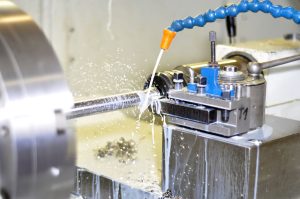Machining is a critical process in manufacturing, where accuracy, efficiency, and safety are essential. However, the process often faces common challenges such as maintaining proper temperature during machining, health risks to employees, chip control, and achieving a quality surface finish. If these issues are not addressed properly, they can lead to costly mishaps. In this blog, we’ll explore these challenges and offer insights on how to avoid them, particularly through innovative solutions like AdaptX (closed-loop internal cooling system), Minimum Quantity Lubrication (MQL), and Dry Machining.
1. Excessive Use of Fluids and Lubricants
One of the most common issues is the excessive use of metalworking fluids. These substances are important for cooling and lubricating in large volumes during the cutting process,but excessive quantities can lead to several problems. Not only does it increase operational expenses, but it also generates more waste, which can be challenging to dispose of responsibly. Excessive fluid use can cause pollution if not properly disposed of, as fluids may contaminate soil, water, and ecosystems. The challenges in disposal include ensuring safe storage, treatment, and preventing leaks or spills, which often require costly infrastructure and strict regulations.
How to Avoid It: To avoid this issue, optimizing the amount of fluid used is crucial.
- Adopt AdaptX Systems: Implement a solution like AdaptX’s- closed-loop internal cooling system that eliminates the need for traditional fluids, helping to cut machining costs by 38% and reduce CO₂ emissions by 91%. By using AdaptX Systems, you not only make the process more sustainable but also lessen your environmental impact.
- Adopt Minimum Quantity Lubrication (MQL): Use MQL systems to apply a minimal amount of lubricant directly to the cutting edge, reducing fluid consumption while maintaining effective lubrication and cooling.
- Use Dry Machining: As the name suggests, dry machining involves cutting without lubrication, relying on high-speed machining techniques and advanced tooling to maintain performance. This eliminates the need for cutting fluids, thereby reducing environmental impact and operational expenses.

2. Health Risks for Employees
The use of metalworking fluids not only impacts the environment but also poses health risks to employees. Prolonged contact with these fluids can lead to skin irritation, allergic reactions, and respiratory problems, especially when mist or vapor is inhaled. This can result in long-term respiratory conditions and dermatitis, affecting both worker health and productivity. These health issues can increase sick days and medical costs, adding to the overall impact of using metalworking fluids. Additionally, the use of these fluids workers and negatively affects the environment.
How to Avoid It:
- AdaptX Cooling System: AdaptX eliminates the use of harmful cutting fluids, promoting a safer work environment. A closed-loop internal cooling system provides a safer work environment by significantly reducing health risks and promoting overall well-being in the workplace.
- MQL (Minimum Quantity Lubrication): MQL minimizes the amount of fluid used, it significantly reduces the exposure risk to harmful substances, creating a safer working environment while maintaining machining performance.
- Dry Machining: Completely removing the need for fluids eliminates any health risks associated with mist inhalation or skin contact. It’s a step towards creating a cleaner and safer shop floor, though it requires advanced tools and strategies to avoid overheating and wear.
- Supercritical CO₂ Cooling: This innovative method uses supercritical carbon dioxide as a cooling agent, which is non-toxic and environmentally friendly. It provides both cooling and lubrication without the harmful side effects associated with traditional fluids.
4. Poor Surface Finish
Achieving a high-quality surface finish is vital in many machining cases, as it directly impacts the functionality and aesthetic appeal of the final product. Poor surface finish can result from several factors, including improper tool selection, inadequate cooling, and incorrect feed rates. A rough or uneven surface can lead to additional processing steps, increasing production time and costs.
How to Avoid It: To avoid poor surface finish, it’s important to choose the right cutting tools and optimize the cutting parameters.
- AdaptX Solution: AdaptX’s advanced cutting technologies can ensure a superior surface finish by providing precise control over the cutting process. This system is designed to target cooling and adjustable temperature ranges to maintain optimal conditions, resulting in consistently smooth and accurate finishes.
- MQL: By providing just the right amount of lubrication at the cutting edge, MQL helps improve surface finish without the excessive mess of traditional fluids.
- Supercritical CO₂ Cooling: Supercritical CO₂ offers excellent lubrication and cooling, resulting in high-quality surface finishes, even in demanding operations. It reduces the chances of tool wear and enhances precision, providing a smooth and even finish.
- Dry Machining & Air Cooling: These methods can still achieve good surface finishes when used with advanced tools designed for high-temperature resilience and proper chip evacuation strategies. The key is optimizing cutting parameters to match the material and tooling used.

Conclusion
Metalworking doesn’t have to be fraught with costly mishaps. By understanding the common challenges and leveraging innovative solutions, such as the sustainable technology offered by AdaptX (Closed-Loop Internal Cooling System) and other advanced techniques like MQL, Dry Machining, Air Cooling, and Supercritical CO₂ Cooling, manufacturers can improve productivity, reduce costs, and create a safer, more sustainable operation.
Adapting to these modern technologies is not just a matter of improving efficiency—it’s about shaping the future of manufacturing in a way that protects both the environment, and the people involved in the process.




